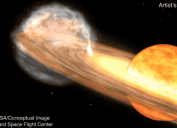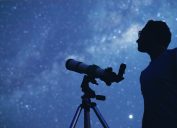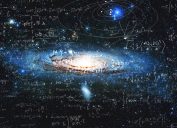"Strong" Meteor Shower Peaks This Week With 30 Shooting Stars an Hour—How to See It
Eta Aquariid will reach its highest state of activity on May 5.

If you missed the April 8 total solar eclipse, don't fret. Stargazers will have the chance to witness another rare celestial event during the early morning hours of May 5, 2024. For the first time since 2013, the Eta Aquariid meteor shower will be "enhanced by debris perturbed by Jupiter" in close proximity to Earth, resulting in a fantastical display of 30 shooting stars per hour, the American Meteor Society (AMS) reports.
RELATED: New Star Will "Explode" in the Night Sky—How to See the "Once-in-a-Lifetime" Event.
The Eta Aquariids began on April 15 and run through May 27; however, the meteor showers peak when Earth "intersects with the dust cloud left by comet Halley," per AMS. This will occur from May 1 to May 10, but the shower will be most active between 2:00 a.m. and 5:00 a.m. local time on Sunday, May 5. During these hours, onlookers can turn skywards for a flashing display of shooting stars in the night sky.
Not to be confused with actual stars, shooting stars are meteoroids made up of "sand and pebble-sized bits of rock" that were once part of an asteroid or, in this case, a comet. When they soar into our atmosphere, it becomes a meteor, also known as a shooting star.
Halley's Comet only orbits the sun every 76 years, but that's not why experts are calling this year's Eta Aquariids rare. As Earth passes through Halley's debris field, the meteor shower will become "quite strong" due to the interaction between those particles and the planet Jupiter, according to AMS.
Additionally, the spectacle will be extra radiant as it's expected to occur days before a new moon. At Aquariids' peak, the moon will be a waning crescent at 14 percent illumination capacity. This means stargazers can observe the shower in a dimly lit sky without moonlight interference.
The organization predicts the meteor shower will produce 10 to 30 shooting stars per hour, flying at 41 miles per second. Unlike the total solar eclipse, this celestial event doesn't require proper safety viewing glasses. Those at northern latitudes can scan for meteor streaks at low points in the sky.
"Try to use a lounge chair that allows you to view half-way up in the sky in comfort. Don't look straight up and most of the activity will be seen in the lower half of the sky. Look high enough to avoid hills and trees that may obscure meteors. Most eta Aquariid meteors will be seen in the eastern half of the sky," explains AMS.
While Aquariids will reach its highest concentration at dawn, it's important to remember the phenomenon is already active. So arriving at your spot early may also benefit you—plus, give your eyes time to adjust to the darkness. Avoid lookouts with skyscrapers, city lights, or areas with looming trees so your view isn't impaired.





















